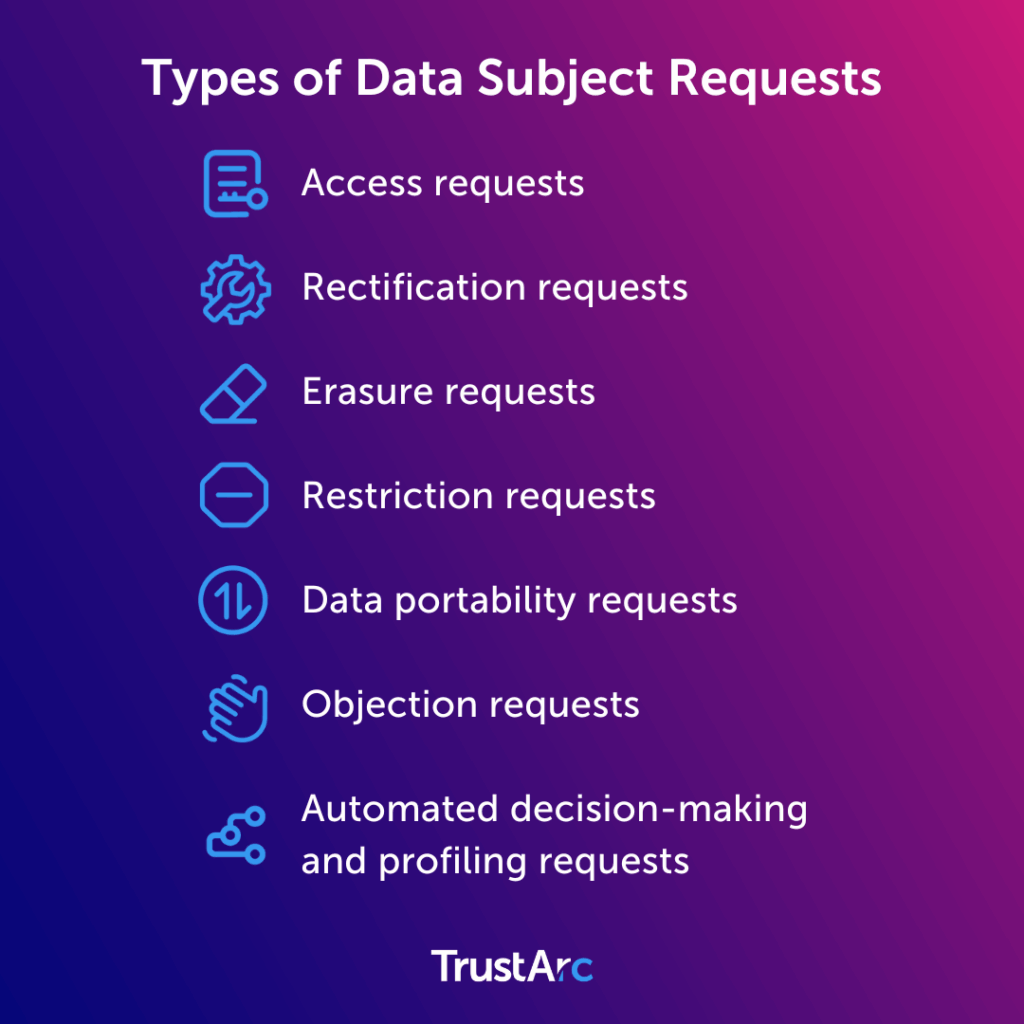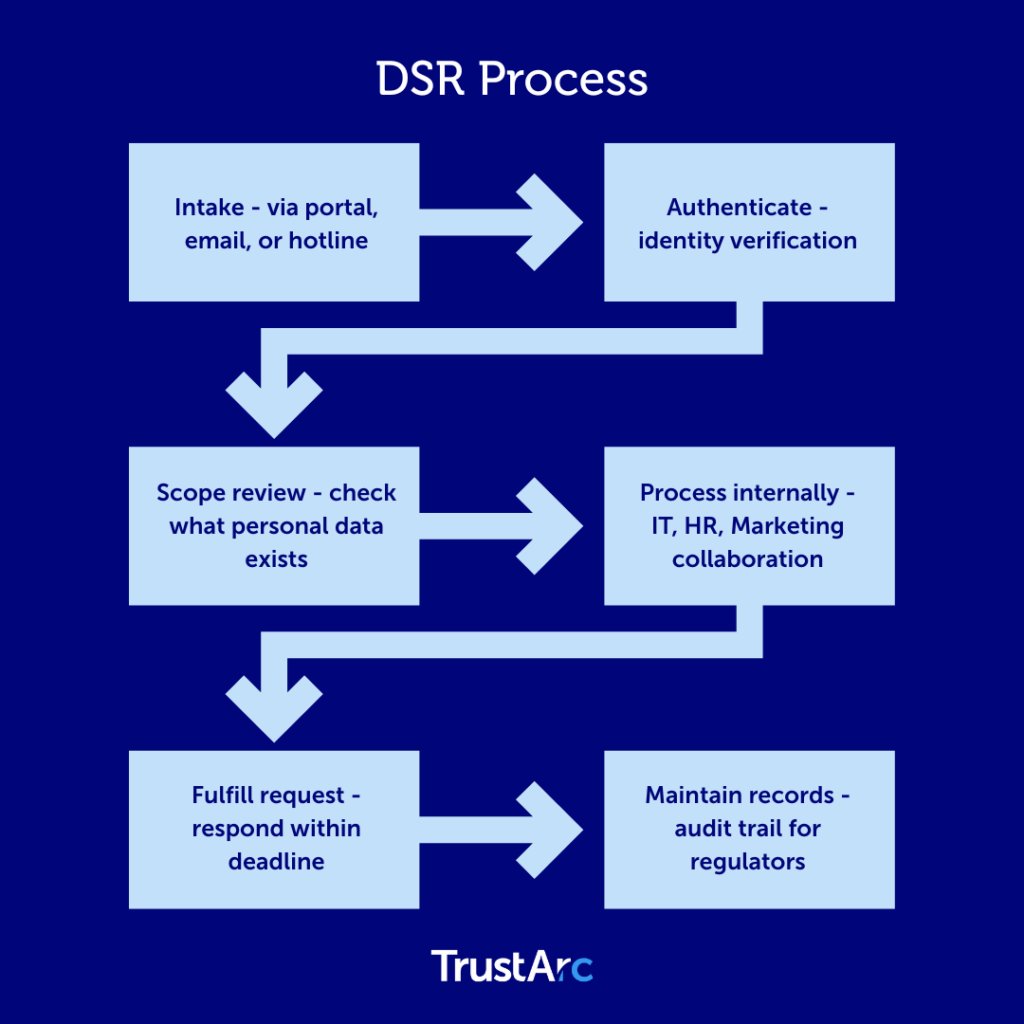Privacy laws and user expectations have converged on one unmissable message: Data Subject Request (DSR) requirements aren’t a “nice to have,” they’re non-negotiable. Individuals have a right to access, delete, correct, port, and otherwise control their personal data, and regulators expect you to make that happen quickly, securely, and consistently. Under the GDPR, fines can reach the greater of €20 million or 4% of global annual revenue. That’s not just a line item; that’s a board-level fire drill.
What is a DSR?
A Data Subject Request is how an individual (customer, employee, prospect—yes, even your test account owner) exercises their data rights with your organization. Common request types include access, deletion (erasure), rectification, portability, restriction/objection, and opt-out of sale/sharing.
Many ask, ‘What are DSR requirements?’ At its core, DSR requirements ensure companies handle these requests lawfully, within deadlines, and with proof.

Request volume is rising. EY’s DSAR survey found 60% of respondents reported an increase year over year; 51% received complaints about DSAR handling; 33% had received “bulk” requests; and 88% process DSARs in-house (often across HR, Legal, IT, and Compliance). Translation: teams are busy, budgets are tight, and spreadsheets snap under scale.
That’s why many organizations are turning to tools like TrustArc’s Individual Rights Manager, which centralizes intake, verification, and fulfillment so requests don’t slip through the cracks.
What is DSR compliance?
Compliance means meeting statutory timelines, verifying identity proportionately, and documenting every step. Regulators don’t just look at whether you respond; they examine how you respond. Two recent cases illustrate this point vividly:
- Clearview AI (France): In 2022, France’s CNIL fined Clearview AI €20 million for multiple GDPR violations, including failures to properly honor and demonstrate compliance with data subject requests. To make matters worse, Clearview was hit with an additional €5.2 million penalty for failing to provide proof of compliance within the two-month follow-up deadline. The case underscores a critical lesson: responding isn’t enough. You must maintain records and be ready to prove compliance when regulators request it.
- Todd Snyder, Inc. (California): In May 2025, the California Privacy Protection Agency fined this clothing retailer $345,178 for CCPA violations tied to its DSR practices. The company required excessive information from individuals trying to exercise their rights and delayed opt-out processing by more than 40 days. The CPPA made it clear: “reasonable” verification means striking a balance. Too little verification invites fraud, but too much creates barriers that regulators see as obstruction.
Whether you’re a global AI company or a mid-market retailer, regulators expect proportionate, timely, and well-documented handling of DSRs. Compliance is about the accountability you can demonstrate under scrutiny, not checking boxes.
Common challenges and pitfalls
On paper, DSR compliance appears straightforward: receive request, verify identity, pull data, respond. In practice, the journey is more like navigating a hedge maze with a stopwatch ticking. Here are the biggest stumbling blocks:
Identity verification delays
Organizations often swing between two extremes. Too weak, and you risk handing sensitive data to an imposter, essentially creating a breach in the name of privacy. Too burdensome, and you frustrate legitimate data subjects, block them from exercising their rights, and invite regulator scrutiny (as Todd Snyder, Inc. learned the hard way). The art is in proportionality: use data you already have to verify requests and reserve additional checks for higher-risk scenarios.
Data silos that stall search and redaction
Data rarely sits neatly in one system. It sprawls across HR platforms, CRM databases, cloud storage, and SaaS apps. Without an integrated discovery process, teams can spend weeks chasing down fragments of information. Worse, inconsistent redaction practices may expose third-party or sensitive data that should have been masked. The result? Delays, errors, and potential over-disclosure.
Inconsistent handling across departments and geographies
Privacy, IT, security, HR, and legal all have roles in DSR fulfillment, but if each team uses its own playbook, you’ll get uneven responses. One business unit might respond within 20 days, while another might take 60. A request in the EU may get handled differently than the same request in the U.S. This inconsistency not only risks noncompliance but also undermines trust if individuals see their rights honored unevenly.
Missed deadlines and mounting risks
Failing to meet statutory deadlines doesn’t just lead to regulator fines; it damages brand trust. A single consumer complaint can escalate into headlines or investigations.
Regulators prize proportionate verification, traceable workflows, and timely responses. Your program should, too. Avoiding these pitfalls isn’t about heroics; it’s about creating a repeatable process that works under pressure, scales with request volume, and proves compliance on demand.
DSR under CCPA and GDPR
At their core, GDPR and CCPA share the same spirit: giving individuals meaningful control over their data. But the way they go about it differs.
GDPR guarantees rights to access, rectification, erasure, restriction/objection, portability, and protection against automated decision-making. Organizations must generally respond within one month, with a possible two-month extension for complex requests (if the individual is notified).
CCPA gives Californians the right to know, delete, correct, opt out of sale or sharing, limit the use of sensitive personal information, and avoid discrimination for exercising their rights. Companies have 45 days to respond, with one possible 45-day extension if they provide notice. CPRA also strengthened enforcement and formally added the right to limit sensitive data use.
EU vs. U.S. approach? Think opt-in versus opt-out. In Europe, you need a lawful basis up front before you can process personal data. In the U.S., individuals often must signal that they want to be excluded through opt-out links, sensitive data limits, or global signals like GPC. One model demands permission in advance; the other expects you to stop only when asked.
Global privacy regulations and DSRs
And it’s not just Europe and California. Regulators worldwide are layering on new requirements:
- Brazil’s LGPD adapts GDPR principles for Latin America.
- India’s DPDPA adds unique consent and localization requirements.
- U.S. state patchwork (Colorado, Virginia, Utah, Connecticut, and counting) keeps expanding the list of overlapping, slightly different rights.
For privacy teams, this means tracking multiple obligations at once, ensuring the right deadlines are met in the right jurisdiction, requests are properly
scoped, and workflows are updated as new laws come online.
Streamlining DSR compliance in a patchwork of global laws
For most organizations, the real challenge isn’t handling a single DSR under GDPR or CCPA. It’s managing dozens or hundreds of requests simultaneously across jurisdictions, each with its own spin on timelines, rights, and verification.
Without a unified system, teams often build parallel processes for each law, duplicating effort and creating inconsistency. One group may track requests in spreadsheets, another in a ticketing system, and another by email. That fragmentation wastes time and increases the risk of missed deadlines and incomplete responses.
It’s like trying to conduct an orchestra with five conductors. The result isn’t a symphony, it’s a cacophony.
This is where TrustArc’s global scope stands out. Instead of stitching together manual workflows law by law, TrustArc enables:
- One workflow — A centralized process that adapts automatically to GDPR, CCPA, LGPD, DPDP, PIPEDA, and beyond.
- Many jurisdictions — Dynamic rules that apply the correct obligations (e.g., 30 days for GDPR, 45 days for CCPA, 15 business days for Colombia).
- Fewer migraines — Automation that handles intake, verification, routing, and fulfillment in a way that’s scalable, auditable, and regulator-ready.
The advantage is efficiency and defensibility. When regulators ask how you handle DSRs, you can point to one consistent system with jurisdiction-specific logic built in. That level of standardization builds both compliance confidence and user trust.
Requirements for the DSR process
Here’s a practical, scalable flow that privacy teams can apply to handle requests with confidence:
- Intake — via portal, email, or hotline
Centralize intake. Funnel every channel into one queue so front-line teams don’t “lose” requests. Offer electronic submission where you process data electronically. - Authenticate — identity verification
Use proportionate methods. Match existing data; avoid collecting new sensitive data unless necessary. Don’t gate simple opt-outs behind intrusive steps. Document your policy. - Scope review — what data exists, where
Inventory systems early (CRM, HRIS, marketing, product logs, vendors). Decide what’s in scope for the specific right invoked, and identify legal holds/retention needs. - Process internally — cross-functional coordination
HR, Legal, IT, Security, and Marketing each own a piece. Define service level agreements (SLAs), escalation paths, and redaction standards. - Fulfill the request — on time, securely
GDPR: one month by default; CCPA: 45 days by default; communicate extensions with reasons. Provide data via a secure portal or method that prevents oversharing. - Maintain records — the audit trail
Track who did what, when, and why (including identity checks, exemptions, and redactions). If you deny or limit a request, explain the rationale and recourse.

Security risks and safeguards
Handling DSRs efficiently requires protecting sensitive data at its most vulnerable moment. When you collect, package, and deliver personal information, you risk exposing the very data you’re trying to protect.
The risks are real:
- Oversharing personal data — Without tight controls, you might disclose more than the requester is entitled to, or accidentally include third-party information.
- Phishing attempts — Bad actors can spoof legitimate DSRs to trick organizations into handing over sensitive data.
- Insecure delivery channels — Sending responses over unencrypted email or without access restrictions can undo all the effort put into compliance.
The safeguards are straightforward but essential:
- Encryption in transit and at rest keeps personal data protected from interception.
- Least-privilege access ensures only the right people inside your organization can touch request files.
- Redaction tools help remove unrelated or sensitive information before delivery.
- Immutable logs provide an audit trail regulators can trust.
- And with claims management companies submitting requests in bulk on behalf of individuals, a “trust but verify” policy is vital — always confirm the individual, not just the agent, before fulfilling requests.
Strong safeguards build confidence with the people exercising their rights. Every secure, accurate response is a signal that your organization takes privacy seriously.
Explore our Data Subject Request Automation to see how secure portals, redaction, and audit logs come standard.
Strategies for meeting DSR requirements
Here’s how to succeed with DSR requirements:
- Train staff regularly. Teach proportionate verification and channel triage; rotate tabletop exercises.
- Build transparent privacy notices. Clarity reduces friction and complaints.
- Create user-friendly request portals. Plain language forms shorten back-and-forth.
- Use automation for tracking and consistency. Standardize templates, timers, and tasks.
Gartner forecasts fines tied to mismanaging subject rights will top $1 billion by 2026—a tenfold increase from 2022—so operational excellence here is risk management, not just reputation polishing. And yes, the average manual cost to process a single DSR has been widely estimated at around $1,524, which is why scalable automation pays for itself fast.
Why do proactive processes reduce costs? Because they reduce escalations, shorten cycle times, and cut rework (the silent budget killer).
Measure request cycle time, first-contact resolution, re-open rates, redaction error rates, and per-request cost monthly.
Technology and automation in DSR compliance
Manual handling is the “fax machine of privacy”: expensive, error-prone, and painfully slow. Automation, by contrast, centralizes intake, orchestrates tasks, codifies timelines, and generates audit trails automatically. Think fewer sticky notes, more state machines.
In practice, the gap is huge. Manual processes often take 3–4 weeks, with requests bouncing between departments and deadlines slipping through the cracks. Automation shortens that cycle to 5–10 days, applying consistent redaction, role-based access, and deadline alerts while generating regulator-ready logs.
The difference isn’t just speed; it’s sustainability. Manual workflows crumble under scale. Automation gives privacy teams repeatability and resilience, turning DSR chaos into an orderly, defensible process. TrustArc’s Individual Rights Manager makes that transformation possible across jurisdictions.
DSR requirements as a foundation for long-term trust
At the heart of DSR requirements are accountability, transparency, and compliance. The near future blends AI-assisted request handling (entity resolution, smart data discovery, automated redaction) with greater regulatory scrutiny of automated tools and a gradual global harmonization of core rights.
Build once, adapt everywhere. Companies that act now on DSR requirements build long-term trust and avoid very short-term risks.
Ready to cut cycle times, costs, and compliance anxiety?
Explore how TrustArc can help you automate DSR workflows. Your team (and your data subjects) will thank you.
DSR Fulfillment, Effortless and Scalable
TrustArc’s Individual Rights Manager automates intake, verification, and fulfillment across 183+ jurisdictions. Cut costs, reduce risk, and respond faster with built-in compliance and 300+ integrations.
Consent Made Simple. Trust Made Strong.
With Consent & Preference Manager, centralize customer choices across apps, sites, and campaigns. Deliver seamless privacy experiences, avoid missed signals, and build lasting trust.
DSR Requirements FAQs
What are DSR requirements under GDPR?
GDPR guarantees rights to access, rectification, erasure, restriction/objection, portability, and safeguards around automated decision-making. Controllers must respond within one month (extendable by two for complex requests with notice), using proportionate identity checks and providing information in a secure, intelligible format.
What are DSR requirements under CCPA?
CCPA/CPRA guarantees rights to know, delete, correct, opt out of sale/sharing, limit use of sensitive PI, and non-discrimination, with a default 45-day response window (and one extension). Businesses must honor user-enabled signals (e.g., GPC), avoid excessive verification for opt-outs, and provide clear mechanisms across channels.
How can companies handle DSRs efficiently?
Centralize intake, use proportionate verification, automate the workflow, secure delivery via a portal, and maintain an auditable record. Platforms like TrustArc’s Individual Rights Manager integrate with your stack, enforce timelines, and produce regulator-ready logs—turning DSR chaos into a consistent, defensible process.







